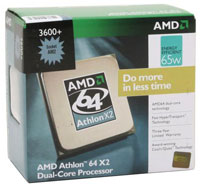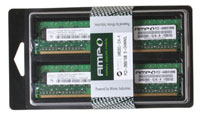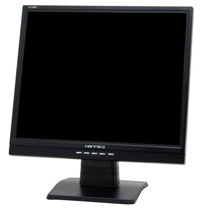Entry Level AMD
The great thing about purchasing a computer right now is that you can get a serious amount of performance for a reasonable price. Our entry level configuration will look to keep price as low as possible without making any major compromises. However, without spending a bit more money it is impossible to purchase a basic computer that will do everything well. The biggest compromise we are making is in the graphics department, where the use of integrated graphics basically means that gaming performance is going to be crippled. For the many people out there that don't care about games, that shouldn't present a problem. It is also relatively simple to upgrade a computer with a discrete graphics card in the future should the need/desire arise.
| AMD Entry Level System |
| Hardware |
Component |
Price |
Rebates |
| Processor |
Athlon 64 X2 3600+ AM2 (Brisbane 1.9GHz 2x512K) - Retail |
$72 |
|
| Motherboard |
ASUS M2A-VM (Socket AM2 AMD 690G) |
$77 |
|
| Memory |
WINTEC AMPO 2x512MB DDR2-800 (5-5-5-12 3AMD2800-1G1K-R) |
$65 |
|
| Hard Drive |
Western Digital Caviar SE16 WD2500KS 250GB 16MB |
$70 |
|
| Optical Drive |
Lite-On 20X DVD+R LH-20A1P-185 |
$34 |
|
| Case |
RAIDMAX APEX ATX-802BP with 450W PSU |
$65 |
|
| Display |
Hanns-G JC-199DPB 19" 8ms (1280x1024) |
$184 |
$40 |
| Speakers |
Cyber Acoustics CA3001WB 14 watts 2.1 Speakers |
$24 |
|
| Keyboard and Mouse |
Microsoft Comfort Curve 2000 B2L-00047 |
$28 |
|
| Operating System |
Windows MCE 2005 or Vista Home Premium (OEM) |
$115 |
|
| Bottom Line |
|
$734 |
$694 |
 |
Prices on AMD's dual core processors are now so low that we see little reason to avoid them. You could shave another $20 off the price by going with a single core Athlon 64 3000+, but that extra $20 buys you potentially twice as much performance. Dual core and multi-core processors are the future, and for those planning to purchase an inexpensive computer and use it for years to come we would just spend the extra money now. The Athlon X2 3600+ (Brisbane core) runs at 1.9GHz and comes with 512K cache per core. Do not confuse this with the 2.0GHz 256K version (Windsor core); the extra cache will almost certainly prove more useful than the extra 100 MHz. For those looking to really cut costs, if you don't want a dual core processor you might as well drop all the way down to the Sempron 64 3000+ (1.6GHz 256K cache) that costs a mere $33. Just don't expect that processor to handle the demands of many applications in three years' time.
 |
Perhaps the most difficult component to get right in any custom-built system is the motherboard. This is particularly true when looking at the budget sector. Buying the least expensive option is rarely the best course of action as features, reliability, stability, and performance can all be compromised. Luckily, the situation is generally better now than it has been in the past, and the integrated memory controller on AMD's processors usually means features and reliability are the only major concerns. For the current cost, the features and performance offered by AMD's 690G chipset put it at the top of our list. Besides a reasonably performing IGP solution - arguably the fastest currently available, though that isn't saying much - you can get VGA, DVI, as well as HDMI video outputs. The ASUS M2A-VM is a micro ATX solution with most of these features, available at a bargain price of only $77. Adding HDMI support will increase the price about $20. It certainly isn't one of the "everything but the kitchen sink" designs, though you can't usually find that without moving beyond the budget sector. This motherboard should also allow at least a moderate amount of overclocking if that's of interest, but that isn't a primary concern here.
 |
We chose DDR2-800 memory, simply because the cost is now at parity with other slower DDR2 memory (i.e. DDR2-667). Memory prices have also become much more reasonable since the beginning of the year, and we're back at the point where 2GB of RAM is available starting at just over $100. We decided not to go that far on entry level configuration, but if you're thinking about running Windows Vista as opposed to Windows XP we would strongly recommend upgrading the memory. On the bright side, at least even micro ATX motherboards are generally offering four DIMM slots these days. For the majority of users, memory timings and overclocking definitely aren't concerns in the budget sector, so we selected an inexpensive Wintec AMPO kit.
For the remaining items, we tried to keep the price down while keeping features and performance as high as possible. We could certainly trim things a bit further (for example getting a 160GB or even 80GB hard drive can save $15-$20), but we prefer to spend slightly more if possible. Getting a less expensive case is something else to consider, and of course those who prefer a little bling have plenty of budget options available. Provided you just want to stay with the basics, you can basically get any cheap case plus power supply and not have any difficulties, but we would still pay attention to user reviews and experiences and do a bit of research first.
 |
The only other major component remaining is the display, and here we were presented with several options. 17" LCDs are the least expensive choice right now, but once you factor in mail-in rebates it really only costs a few dollars more to get a 19" LCD. Some people might actually like the slightly smaller LCD for whatever reason, but we would definitely take a larger LCD first. Looking at the 19" LCDs, you then have to decide between standard aspect ratio and widescreen offerings. We like widescreens for the most part, but it seems like corners are being cut on the panels in order to keep costs down, and actual surface area is slightly larger on a standard aspect ratio display. Hanns G is one of many display manufacturers that most people aren't familiar with, but the reality is that there are only a few actual panel manufacturers. The quality of LCD panels has also reached the point where even the budget offerings look good and perform well. Long-term quality and support is a bit harder to judge, but the average user consensus is that this particular LCD is a very good budget option.














46 Comments
View All Comments
Gary Key - Friday, April 20, 2007 - link
We debated this choice. We feel like the Biostar 690G board is an excellent choice and is probably our favorite 690G board although the Sapphire board has been impressive with the latest BIOS release. The debate originally was to spend a little less on the Asus board and get the 3800+ X2 instead of the 3600+ X2, in the end it was the Asus/3600+ and moving up to a nice 19" monitor to come in under $700.OrSin - Friday, April 20, 2007 - link
Sorry but buying the slow C2D and then pairing it with $70 HSF to me is counter productive. Why spend almost 60% of the CPU+hsf combo on cooling. The intel stock cooler with a faster CPU will still OC fine and get to atleast the same speeds and the 4300. With more head room and lower voltage. Also their are several after market HSF that cost under $30 that work great. Sorry I dont see paring this monster HSF with the lowest CPU.iluvdeal - Monday, April 23, 2007 - link
I'm thinking the same thing, the escalating cost of some HSFs are muting the price/performance you are getting out of your CPU. You might as well spend that extra $70 on a higher CPU and just use the stock HSF.Maybe AnandTech can do an article involving much overclock you get for your money? For example, if you can achieve a 20% OC for "free" using the stock HSF, how does that overclock increase as the price of the HSF goes up?
AnnonymousCoward - Sunday, April 22, 2007 - link
60%? Try 34%. 70/(135+70)MarxMarvelous - Friday, April 20, 2007 - link
I agree - especially when you can get a Scythe Ninja for $40.http://www.newegg.com/product/product.asp?item=N82...">http://www.newegg.com/product/product.asp?item=N82...
JarredWalton - Friday, April 20, 2007 - link
Different strokes for different folks....I like to get a top-quality HSF if I'm serious about overclocking, and I'd say there's a reasonable chance you *won't* get 3.6GHz out of the E4300 without it - about 50/50 depending on CPU. As for cost, an E6400 with Scythe Ninja as an example will end up costing a bit more, but to 3.6GHz you will also need a board and RAM that can run at 450 FSB/DDR2-900 without issues. More likely than not, you will end up spending more money on the RAM just to be safe, and in the end performance is about the same.
Anyway, we have our separate review sections for a reason, and people still don't come to a single consensus on individual parts. When you have to then put together a complete build, every little decision can be debated. Going with a Tuniq 120 for $50 seems like a better idea than a Scythe Ninja if you don't want the Ultra 120. I just like the fact that you get to choose a fan that suits your needs with the Ultra 120 - either for quiet or for maximum OC or somewhere in between. The heatsink only runs about $50, but I figured another $10-$20 for the fan is typical.
OrSin - Friday, April 20, 2007 - link
Oh yeah still good article. It give people a very good picture of where things are.mostlyprudent - Friday, April 20, 2007 - link
Did I miss it, or is there no discussion of the Raidmax case in the article? Anyone know which brand PSU that case uses?Zepper - Sunday, April 22, 2007 - link
The PSU in the Raidmax Apex - I can't read the "E" number under the RU seal so I could check it out on the UL.com site. IAC, it's a junk-bucket with less than half its watts available on its one +12 rail - not even designed for a modern system where the 12V rail is king. For some reason Jarred never acts as if the PSU is the cornerstone of a stable system. I'd be ashamed if I was Jarred.He got lucky on the fancer system as the PSU in the Athenatech is made by Topower. Not great by any stretch, but not a junk-bucket either.
.bh.
Chunga29 - Sunday, April 22, 2007 - link
It's a budget PC for God's sake! Look at the components and tell me with a straight face that even a low-end PSU is going to fail to provide enough power. If you can do that, then I have the name of a shrink that can help with your uhnealthy PSU obesession. IGP + no overclocking + 1 drive = about 110W power draw.